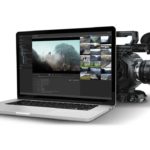
REVIEW: Sennheiser AMBEO Ambisonic Microphone
Posted on Mar 6, 2017
Sennheiser has made its first Ambisonics microphone – making sense of this decades’ old technology
WORDS ADAM GARSTONE
The LASER was invented in 1959 by Gordon Gould (probably). Sadly, nobody could really think of anything to do with it until the invention of CD players, Laser Quest and the Laser Interferometer Gravitational-Wave Observatory.
And it happened again when Peter Fellget and Michael Gerzon invented Ambisonics in the 1970s. Everyone was terribly excited, but no one could think of anything to do with it. Here was a technique which allowed accurate spatialisation of sound recordings not only in 360° around the listener, but also 360° above and below. It was wonderful technology, but recording it was expensive and no one had the speaker set-up to listen to it. So, it remained firmly in its niche, with only a couple of specialist manufacturers making microphones.
In the 21st century, digital recording and encoding, coupled with a demand from the likes of VR and Dolby Atmos, has made the technology interesting enough that a mainstream manufacturer has now made an Ambisonic microphone. Sennheiser’s AMBEO VR combines four, high-quality microphone capsules in a tetrahedron to capture true, Ambisonic signals.
A new heavyweight?
Sennheiser knows a thing or two about making microphones, and the AMBEO VR is very solidly made, with a chunky casting holding the four, 14mm capsules beneath a removable cover. The entire unit oozes quality, not least in terms of weight.
The four capsules are broken out into four standard XLRs. You need to provide phantom power to each connector and, obviously, four good quality mic-pres and ADCs. The world of Ambisonics refers to this raw, four-channel signal as A-format. Sennheiser supplies a free plug-in for most major DAWs to encode these four channels to Ambisonic’s B-format, which is what most other plug-ins understand. B-format also has four discrete signals loosely representing an omni mic, and three figure of eights – left-right, front-back and up-down.
We used Sound Devices 788T field recorder to capture A-format recordings. It’s worth pointing out that many of the previous Ambisonic microphones had hardware units to convert to B-format, so the 788T has a rudimentary B-format to Stereo matrix to allow some kind of meaningful monitoring on the headphone output. Unfortunately, you can’t monitor a raw A-format signal like that produced by the AMBEO VR – other than by selecting channels to check for signal presence.
The AMBEO VR’s mic capsules have to be small enough to get them close together. Surprisingly, for 14mm capsules, Sennheiser quotes a 20Hz to 20kHz frequency response – similar mics usually only manage 40Hz. Delving further into the specs reveals rather lower sensitivity, and higher noise, than other field recording mics, but in practice we didn’t notice any problems, and appreciated the lower frequency response when extracting an LFE channel.
Your flexible friend
Which brings me on to the flexibility – it’s possible to mimic the responses of other microphone patterns. The AMBEO VR records spatially accurate sound from a sphere around the mic, so with some clever maths, plug-ins can extract, say, a stereo signal. The resulting audio can sound exactly like it was recorded with a crossed pair of cardioid mics, and you can point this pair in different directions after the recording. Or you could extract five channels for conventional surround sound. You can even mimic several microphones at the same time.
There are a variety of free plug-ins available, but Harpex Ltd’s software is worth a look. It’s expensive, but justifies the price with excellent spatial accuracy and outstanding flexibility. A single AMBEO VR recording can be decoded into stereo, surround, binaural – it even mimics a highly directional mic, like a short shotgun but with a nicer off-axis response.
One benefit of recording using a tetrahedron mic like the AMBEO VR is that it minimises the phase effects you can get with multiple mic recording techniques – the capsules are close enough together to (almost) represent a single point. If the conditions allow, many recordists remove the basket to ensure it doesn’t produce any unwanted high-frequency effects, but the AMBEO VR kit also contains a simple, foam windshield if conditions aren’t so helpful, and a simple but effective Rycote shock mount.
There can be phase issues on playback, however, when the listener moves, as the ‘point source’ recording is played back with high correlation through several speakers. In practice, VR usually uses headphones and auditoria for full surround playback, like Dolby Atmos, are seated, restricting audience movement.
So Sennheiser has produced an outstanding microphone with the AMBEO VR. It’s built to withstand the rigours of field recording, and has the sound quality and flexibility to be the only Ambisonics recording mic you’ll ever need – equally at home capturing forest sounds in the Amazon, the Staatskapelle Berlin at full chat, or battlefield sounds for the next big movie.
The AMBEO VR is £1440 inc. VAT













